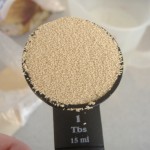 A lot of people are afraid of yeast. Yeast is, perhaps, the most important ingredient in any bread recipe. This is because if your yeast isn’t working properly, you’ll end up with a dense brick of bread that probably isn’t fit for most ducks. Therefore, people either don’t make bread, make bad bread, or make quick breads that don’t have anything to do with yeast.
A lot of people are afraid of yeast. Yeast is, perhaps, the most important ingredient in any bread recipe. This is because if your yeast isn’t working properly, you’ll end up with a dense brick of bread that probably isn’t fit for most ducks. Therefore, people either don’t make bread, make bad bread, or make quick breads that don’t have anything to do with yeast.
I am here to tell you that making yeast breads is one of the most satisfying things you can do. And it doesn’t take very long. And I am going to tell you how to do it, step by step. I will be referring back to this post in the future when I write about bread, because as long as you understand the basic principles set forth in this post, you will soon discover that you can make bagels, challah, and even artisan breads. Stick with me, kid, and you’ll be farting through silk. So, shall we begin?
I am one of those obnoxious people who doesn’t really use a recipe when I make basic bread. This is because I understand three simple principles about making bread:
1 cup of water for every three cups of flour.
At least two teaspoons of yeast.
At least one teaspoon of salt.
If you can remember those three things, you’re already ahead of the game. However, I’m not cruel, so I am going to give you a basic bread recipe. This recipe will make either one pretty decent-sized loaf in a regular loaf pan, or about 9 nice-sized bagels. Oh, the recipe says that it will give you a dozen bagels. Trust me. You’ll get 9. So, if you want more bagels, make more dough.
I want to pause here to say that I’m not a snob: If you want to toss all of the ingredients into a bread machine and hit the “dough” button, or just make bread, then, hey, good for you! It will be delicious and your family will love it. I like kneading dough, and sometimes it’s worth it to knead it just so I don’t have to pry it off the bread machine hook, but you know what works best for you, so go for it.
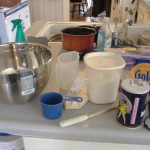 Bread Dough Recipe
Bread Dough Recipe
 Print This Recipe
Print This Recipe
1 T yeast
1 1/2 c lukewarm water
2 T sugar
4-4 3/4 c flour
1 T salt
__________________________________________________________________________________________
Activating the yeast
The first thing you’re going to do is to fill up a liquid measuring cup with your 1 1/2 c. of lukewarm water. When I say lukewarm, I mean the temperature that you would put a baby into. If you use cold water, your yeast will be a little cold and sluggish. It’s not impossible to make bread with cold water; it just takes longer. But DO NOT USE HOT WATER. That will kill your yeast, and then you’re stuck. I like to buy my yeast loose in a jar, but you can certainly buy the little individual packages. It’s just cheaper to buy it by the jar.
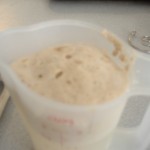 We are going to make sure our yeast is nice and active and alive. So, we are going to add our yeast to that measuring cup with our 2 T of sugar. Don’t worry — that much sugar won’t give you a sweet bread. It’s for the yeast to eat, to activate it faster. Your yeast works because it eats sugar and flour, drinks the water, and then emits gasses that make the bread rise. Sorry to de-romanticize it for you, but good bread requires yeast to fart. Period.
We are going to make sure our yeast is nice and active and alive. So, we are going to add our yeast to that measuring cup with our 2 T of sugar. Don’t worry — that much sugar won’t give you a sweet bread. It’s for the yeast to eat, to activate it faster. Your yeast works because it eats sugar and flour, drinks the water, and then emits gasses that make the bread rise. Sorry to de-romanticize it for you, but good bread requires yeast to fart. Period.
After you do that, you can move on and add four cups of flour (reserve the extra 3/4) and your salt to a large mixing bowl. Then, go vacuum a room or do some dishes or listen to a couple of great songs z– give the yeast about 15 minutes to show its stuff. When you return to it, it will be doubled in size, bubbly in your cup. If it isn’t, then your yeast may not be good, and you might want to get new yeast before you bake your bread. You’ll want to store that in your refrigerator, please.
Adding flour and salt
Once your yeast mixture is nice and bubbly, add it to the flour/salt mixture. Salt serves to slow the action of the yeast. This isn’t really important unless you’re making artisan breads with a sourdough starter that doesn’t have any commercial yeast in it, but it’s an interesting tidbit I thought I’d share.
Kneading
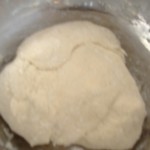 You may want to start with mixing up your ingredients with a wooden spoon. Eventually, though, you’re going to have to get your hands in there (unless you are using a bread machine or a large mixer). Kneading bread is just like folding towels. You get under the whole mess with your hand and then fold it over on itself. Then do it again. And again. And again. You basically just keep folding it and making a smooth ball out of it. You can knead with one hand, though I invariably end up using two.
You may want to start with mixing up your ingredients with a wooden spoon. Eventually, though, you’re going to have to get your hands in there (unless you are using a bread machine or a large mixer). Kneading bread is just like folding towels. You get under the whole mess with your hand and then fold it over on itself. Then do it again. And again. And again. You basically just keep folding it and making a smooth ball out of it. You can knead with one hand, though I invariably end up using two.
If you are mixing or kneading, you may notice, depending on how humid the day is, that your dough seems particularly sticky. If that’s the case, then add some of that 3/4 cup flour you reserved. Keep adding until the dough stops being tacky and sticky when you knead it. Conversely, if the dough is dry and stiff, don’t be afraid to add water, about a teaspoon at a time, until the dough becomes more elastic and softer.
Some people advise kneading for at least ten minutes. I think you can knead til its smooth and it starts to resemble, in texture, a baby’s bottom. If you don’t know what this feels like, try to borrow a baby and squeeze it’s bottom. Or, it should look roughly like this picture to the right. Your recipe is a guideline. Don’t be afraid to listen to your bread and what it needs.
Rising
Now, you have a dough that can be used for pizza, baguettes, bagels, rolls, or cinnamon bread. Use your imagination! Or bread. Yeah, bread. IDEALLY, you want this to rise for an hour so the bread can let the yeast eat and do its thing for awhile, and because it improves both the texture and the flavor of your dough. However, I will admit that sometimes I just roll it out and start topping it for pizza. Bread isn’t a science. It is supposed to work for you, not defeat you. But if you have an hour, then let it rise.
Because yeast likes a warm environment, use a dishtowel to cover your bowl. You can warm your oven and then TURN IT OFF. Put your dough in the oven, and slip a hot pad into the door so it’s open a crack. In the summer, your counter (with a dishtowel) should be fine.
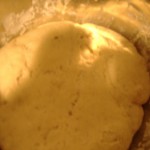 When you have let it rise (sometimes, it will double in size; sometimes, it will relax a lot; bread is a tricky thing, because yeast is alive, so there will be variations), punch it down, form it back into a small ball again. Then, you are ready to use it.
When you have let it rise (sometimes, it will double in size; sometimes, it will relax a lot; bread is a tricky thing, because yeast is alive, so there will be variations), punch it down, form it back into a small ball again. Then, you are ready to use it.
Baking
What? What’s that? How do you use it? How do you make all of these wonderful things? Tune in next week, and we’re going to make bagels. In the meantime, toss the dough into a loaf pan and bake it for about 45 minutes at 350 degrees. It should come easily out of the pan, and then tap it on the bottom. When it sounds hollow, it’s done. Enjoy!